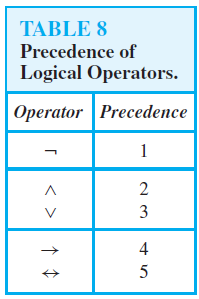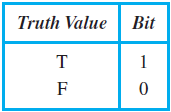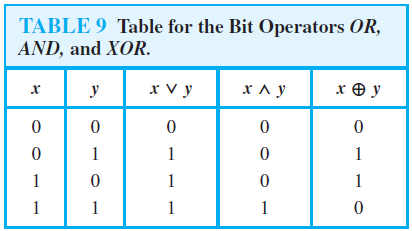SKEDSOFT
Precedence of Logical Operators
We can construct compound propositions using the negation operator and the logical operators defined so far.We will generally use parentheses to specify the order in which logical operators in a compound proposition are to be applied. For instance, (p ∨ q) ∧ (¬r) is the conjunction of p ∨ q and ¬r. However, to reduce the number of parentheses, we specify that the negation operator is applied before all other logical operators. This means that ¬p ∧ q is the conjunction of¬p and q, namely, (¬p) ∧ q, not the negation of the conjunction ofp and q, namely¬(p ∧ q). Another general rule of precedence is that the conjunction operator takes precedence over the disjunction operator, so that p ∧ q ∨ r means (p ∧ q) ∨ r rather than p ∧ (q ∨ r). Because this rule may be difficult to remember, we will continue to use parentheses so that the order of the disjunction and conjunction operators is clear.

Finally, it is an accepted rule that the conditional and biconditional operators → and ↔ have lower precedence than the conjunction and disjunction operators, ∧ and ∨. Consequently, p ∨ q → r is the same as (p ∨ q) → r. We will use parentheses when the order of the conditional operator and biconditional operator is at issue, although the conditional operator has precedence over the biconditional operator. Table 8 displays the precedence levels of the logical operators, ¬, ∧, ∨,→, and↔.
Logic and Bit Operations
Computers represent information using bits.A bit is a symbol with two possible values, namely, 0 (zero) and 1 (one). This meaning of the word bit comes from binary digit, because zeros and ones are the digits used in binary representations of numbers. The well-known statistician John Tukey introduced this terminology in 1946.A bit can be used to represent a truth value, because there are two truth values, namely, true and false. As is customarily done, we will use a 1 bit to represent true and a 0 bit to represent false. That is, 1 represents T (true), 0 represents F (false).A variable is called a Boolean variable if its value is either true or false. Consequently, a Boolean variable can be represented using a bit.
Computer bit operations correspond to the logical connectives. By replacing true by a one and false by a zero in the truth tables for the operators ∧, ∨, and ⊕, the tables shown in Table 9 for the corresponding bit operations are obtained.We will also use the notation OR, AND, and XOR for the operators ∨,∧, and ⊕, as is done in various programming languages.


Information is often represented using bit strings, which are lists of zeros and ones. When this is done, operations on the bit strings can be used to manipulate this information.